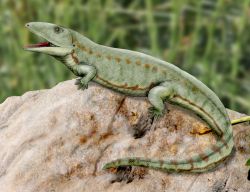Labyrinthodontia
Labyrinthodontia is an extinct subclass of amphibians, which is known from fossils dating from the Late Devonian period to the Late Triassic, although there is some debate about the exact time range. This group is named for the distinctive labyrinthine pattern of infolding of the dentine and enamel in the teeth, a feature that was first identified in the early 19th century. Labyrinthodonts were among the earliest terrestrial vertebrates, and their study provides important insights into the transition from aquatic to terrestrial life.
Characteristics[edit | edit source]
Labyrinthodonts were characterized by several distinctive features apart from their unique tooth structure. They typically had robust bodies, short limbs, and a skull that was either heavily ossified or showed a degree of larval paedomorphosis (retention of juvenile traits in the adult form). Their skin was thick and often covered in scales, providing protection against desiccation and predators. The size of labyrinthodonts varied significantly, ranging from small, almost amphibian-like creatures to large predators several meters in length.
Classification[edit | edit source]
The classification of Labyrinthodontia has undergone significant changes over time. Initially, all large, early tetrapods with labyrinthodont teeth were grouped together. However, with advances in paleontology and the discovery of more fossils, it became clear that the group was paraphyletic—meaning it included the common ancestor and some, but not all, of its descendants. Today, Labyrinthodontia is not used as a formal taxonomic group in scientific literature but as a descriptive term for a broad assemblage of early tetrapod groups that share common features, including Temnospondyli, Anthracosauria, and certain early amniotes.
Habitat and Lifestyle[edit | edit source]
Labyrinthodonts inhabited a wide range of environments, from fully aquatic to predominantly terrestrial ecosystems. Their diets were equally varied, including insects, fish, and smaller tetrapods, indicating a range of predatory and possibly scavenging behaviors. The diversity in size and form within labyrinthodonts suggests they occupied a variety of ecological niches.
Evolution and Extinction[edit | edit source]
Labyrinthodonts evolved in the late Devonian, a time when the first vertebrates were making the transition to land. Their evolution is closely tied to the development of limbs capable of supporting the body on land, the evolution of lungs for breathing air, and changes in their reproductive strategies to cope with terrestrial environments. The decline and eventual extinction of labyrinthodonts are believed to be linked to the dramatic environmental changes that occurred at the end of the Permian period, as well as competition with more advanced reptiles that were better adapted to dry conditions.
Legacy[edit | edit source]
The study of labyrinthodonts has significantly contributed to our understanding of vertebrate evolution, particularly the transition from aquatic to terrestrial life. Their fossils provide valuable insights into the morphology, ecology, and evolutionary history of early tetrapods. Despite their extinction, labyrinthodonts are considered a key group in understanding the evolutionary lineage leading to modern amphibians and, by extension, the broader history of vertebrate life on land.
This article is a paleontology stub. You can help WikiMD by expanding it!
Search WikiMD
Ad.Tired of being Overweight? Try W8MD's physician weight loss program.
Semaglutide (Ozempic / Wegovy and Tirzepatide (Mounjaro / Zepbound) available.
Advertise on WikiMD
|
WikiMD's Wellness Encyclopedia |
| Let Food Be Thy Medicine Medicine Thy Food - Hippocrates |
Translate this page: - East Asian
中文,
日本,
한국어,
South Asian
हिन्दी,
தமிழ்,
తెలుగు,
Urdu,
ಕನ್ನಡ,
Southeast Asian
Indonesian,
Vietnamese,
Thai,
မြန်မာဘာသာ,
বাংলা
European
español,
Deutsch,
français,
Greek,
português do Brasil,
polski,
română,
русский,
Nederlands,
norsk,
svenska,
suomi,
Italian
Middle Eastern & African
عربى,
Turkish,
Persian,
Hebrew,
Afrikaans,
isiZulu,
Kiswahili,
Other
Bulgarian,
Hungarian,
Czech,
Swedish,
മലയാളം,
मराठी,
ਪੰਜਾਬੀ,
ગુજરાતી,
Portuguese,
Ukrainian
Medical Disclaimer: WikiMD is not a substitute for professional medical advice. The information on WikiMD is provided as an information resource only, may be incorrect, outdated or misleading, and is not to be used or relied on for any diagnostic or treatment purposes. Please consult your health care provider before making any healthcare decisions or for guidance about a specific medical condition. WikiMD expressly disclaims responsibility, and shall have no liability, for any damages, loss, injury, or liability whatsoever suffered as a result of your reliance on the information contained in this site. By visiting this site you agree to the foregoing terms and conditions, which may from time to time be changed or supplemented by WikiMD. If you do not agree to the foregoing terms and conditions, you should not enter or use this site. See full disclaimer.
Credits:Most images are courtesy of Wikimedia commons, and templates, categories Wikipedia, licensed under CC BY SA or similar.
Contributors: Prab R. Tumpati, MD






